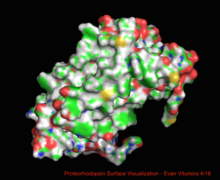This article may be too technical for most readers to understand. (May 2016) |
| Proteorhodopsin | |
|---|---|
 Proteorhodopsin Cartoon Visualization by ELViture | |
| Identifiers | |
| Symbol | Bac_rhodopsin |
| InterPro | IPR017402 |
| SCOP2 | 2brd / SCOPe / SUPFAM |
| TCDB | 3.E.1 |
| OPM superfamily | 6 |
| OPM protein | 4hyj |
Proteorhodopsin (also known as pRhodopsin) is a family of transmembrane proteins that use retinal as a chromophore for light-mediated functionality, in this case, a proton pump. pRhodopsin is found in marine planktonic bacteria, archaea and eukaryotes (protae), but was first discovered in bacteria.[1][2][3][4]
Its name is derived from proteobacteria (now called Pseudomonadota) that were named after Ancient Greek Πρωτεύς (Proteus), an early sea god mentioned by Homer as "Old Man of the Sea", Ῥόδος (rhódon) for "rose", due to its pinkish color, and ὄψις (opsis) for "sight". Some members of the family, Homologous rhodopsin-like pigments, i.e. bacteriorhodopsin (of which there are more than 800 types) have Sensory Functions like opsins, integral for visual phototransduction. Many of these sensory functions are unknown – for example, the function of Neuropsin in the human retina.[5] Members are known to have different absorption spectra including green and blue visible light.[6][7][8][9][10][11]
- ^ Béjà O, Aravind L, Koonin EV, Suzuki MT, Hadd A, Nguyen LP, Jovanovich SB, Gates CM, Feldman RA, Spudich JL, Spudich EN, DeLong EF (Sep 2000). "Bacterial rhodopsin: evidence for a new type of phototrophy in the sea". Science. 289 (5486): 1902–6. Bibcode:2000Sci...289.1902B. doi:10.1126/science.289.5486.1902. PMID 10988064.
- ^ Lin S, Zhang H, Zhuang Y, Tran B, Gill J (Nov 2010). "Spliced leader-based metatranscriptomic analyses lead to recognition of hidden genomic features in dinoflagellates". Proceedings of the National Academy of Sciences of the United States of America. 107 (46): 20033–8. Bibcode:2010PNAS..10720033L. doi:10.1073/pnas.1007246107. PMC 2993343. PMID 21041634.
- ^ Slamovits CH, Okamoto N, Burri L, James ER, Keeling PJ (2011). "A bacterial proteorhodopsin proton pump in marine eukaryotes". Nature Communications. 2 (2): 183. Bibcode:2011NatCo...2..183S. doi:10.1038/ncomms1188. PMID 21304512.
- ^ Frigaard NU, Martinez A, Mincer TJ, DeLong EF (Feb 2006). "Proteorhodopsin lateral gene transfer between marine planktonic Bacteria and Archaea". Nature. 439 (7078): 847–50. Bibcode:2006Natur.439..847F. doi:10.1038/nature04435. PMID 16482157. S2CID 4427548.
- ^ Buhr ED, Yue WW, Ren X, Jiang Z, Liao HW, Mei X, Vemaraju S, Nguyen MT, Reed RR, Lang RA, Yau KW, Van Gelder RN (20 Oct 2015). ""Neuropsin (OPN5)-mediated photoentrainment of local circadian oscillators in mammalian retina and cornea"". Proceedings of the National Academy of Sciences. 112 (42): 13093–13098. Bibcode:2015PNAS..11213093B. doi:10.1073/pnas.1516259112. PMC 4620855. PMID 26392540.
- ^ Béjà O, Spudich EN, Spudich JL, Leclerc M, DeLong EF (Jun 2001). "Proteorhodopsin phototrophy in the ocean". Nature. 411 (6839): 786–9. Bibcode:2001Natur.411..786B. doi:10.1038/35081051. PMID 11459054. S2CID 4428964.
- ^ Man D, Wang W, Sabehi G, Aravind L, Post AF, Massana R, Spudich EN, Spudich JL, Béjà O (Apr 2003). "Diversification and spectral tuning in marine proteorhodopsins". The EMBO Journal. 22 (8): 1725–31. doi:10.1093/emboj/cdg183. PMC 154475. PMID 12682005.
- ^ Kelemen BR, Du M, Jensen RB (Dec 2003). "Proteorhodopsin in living color: diversity of spectral properties within living bacterial cells". Biochimica et Biophysica Acta (BBA) - Biomembranes. 1618 (1): 25–32. doi:10.1016/j.bbamem.2003.10.002. PMID 14643930.
- ^ Sabehi G, Kirkup BC, Rozenberg M, Stambler N, Polz MF, Béjà O (May 2007). "Adaptation and spectral tuning in divergent marine proteorhodopsins from the eastern Mediterranean and the Sargasso Seas". The ISME Journal. 1 (1): 48–55. doi:10.1038/ismej.2007.10. PMID 18043613.
- ^ Encyclopedia of the Neruological Sciences. Academic Press. 29 April 2014. p. 441. ISBN 978-0-12-385158-1.
- ^ Giese, Arthur C (Sep 2013). Photophysiology: General Principles; Action of Light on Plants. Elsevier. p. 9. ISBN 978-1-4832-6227-7.